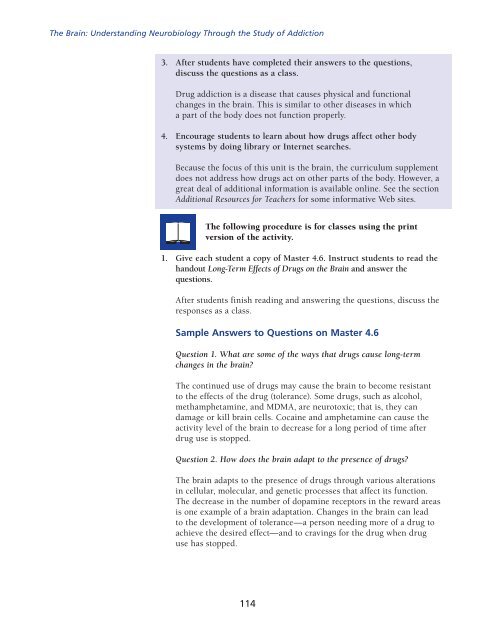Drug Abuse And Addiction - NIH Office of Science Education
Drug Abuse And Addiction - NIH Office of Science Education
Drug Abuse And Addiction - NIH Office of Science Education
Create successful ePaper yourself
Turn your PDF publications into a flip-book with our unique Google optimized e-Paper software.
The Brain: Understanding Neurobiology Through the Study <strong>of</strong> <strong>Addiction</strong>3. After students have completed their answers to the questions,discuss the questions as a class.<strong>Drug</strong> addiction is a disease that causes physical and functionalchanges in the brain. This is similar to other diseases in whicha part <strong>of</strong> the body does not function properly.4. Encourage students to learn about how drugs affect other bodysystems by doing library or Internet searches.Because the focus <strong>of</strong> this unit is the brain, the curriculum supplementdoes not address how drugs act on other parts <strong>of</strong> the body. However, agreat deal <strong>of</strong> additional information is available online. See the sectionAdditional Resources for Teachers for some informative Web sites.The following procedure is for classes using the printversion <strong>of</strong> the activity.1. Give each student a copy <strong>of</strong> Master 4.6. Instruct students to read thehandout Long-Term Effects <strong>of</strong> <strong>Drug</strong>s on the Brain and answer thequestions.After students finish reading and answering the questions, discuss theresponses as a class.Sample Answers to Questions on Master 4.6Question 1. What are some <strong>of</strong> the ways that drugs cause long-termchanges in the brain?The continued use <strong>of</strong> drugs may cause the brain to become resistantto the effects <strong>of</strong> the drug (tolerance). Some drugs, such as alcohol,methampheta mine, and MDMA, are neurotoxic; that is, they candamage or kill brain cells. Cocaine and amphetamine can cause theactivity level <strong>of</strong> the brain to decrease for a long period <strong>of</strong> time afterdrug use is stopped.Question 2. How does the brain adapt to the presence <strong>of</strong> drugs?The brain adapts to the presence <strong>of</strong> drugs through various alterationsin cellular, molecular, and genetic processes that affect its function.The decrease in the number <strong>of</strong> dopamine receptors in the reward areasis one example <strong>of</strong> a brain adaptation. Changes in the brain can leadto the development <strong>of</strong> tolerance—a person needing more <strong>of</strong> a drug toachieve the desired effect—and to cravings for the drug when druguse has stopped.114
















